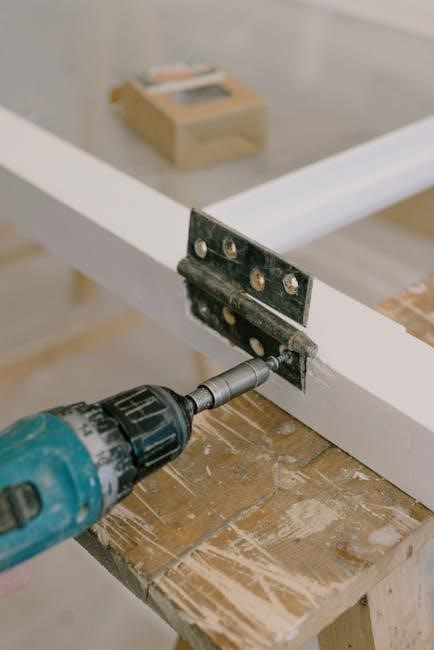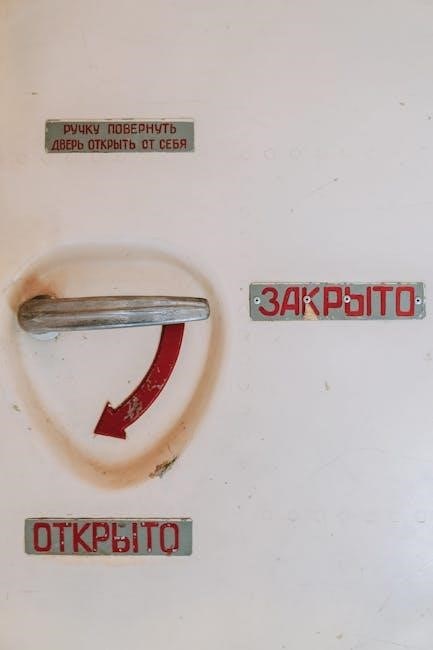pocket door assembly instructions
Pocket door assembly instructions provide a step-by-step guide on installing doors, requiring careful planning and execution to ensure proper functioning and safety, using various tools and materials, following specific manufacturer guidelines.
Understanding the Benefits of Pocket Doors
Pocket doors offer numerous benefits, including space-saving design, ease of use, and aesthetic appeal, making them a popular choice for homeowners and office spaces. They disappear into the wall when opened, creating a seamless transition between rooms. This design allows for more floor space, which can be utilized for furniture, decorations, or other purposes. Additionally, pocket doors are often more cost-effective than traditional doors, as they require less material and labor to install. They also provide a sleek and modern look, which can enhance the overall appearance of a room. With the ability to install pocket doors yourself, you can avoid the hassle of hiring a contractor, saving time and money. Overall, pocket doors are a versatile and practical solution for any room, offering a range of benefits that make them an attractive option for those looking to upgrade their space. They are perfect for closing off open sections or adding a quick way to move between rooms.
Importance of Following Manufacturer Instructions
Following manufacturer instructions is crucial when assembling and installing pocket doors, as it ensures a safe and proper installation. The instructions provide a step-by-step guide on how to assemble the frame, install the header, and mount the door, taking into account the specific design and requirements of the door. By following the manufacturer’s instructions, you can avoid common mistakes and potential safety hazards, such as improper alignment or insecure mounting. The instructions also provide important information on the tools and materials required, as well as any specific precautions or considerations that need to be taken into account. Additionally, following the manufacturer’s instructions can help to prevent damage to the door or surrounding walls, and ensure that the door functions smoothly and efficiently. It is essential to read and understand the instructions carefully before starting the installation process, and to follow them precisely to ensure a successful and trouble-free installation. This will also help to maintain the warranty and longevity of the door.

Preparing the Wall Cavity
Constructing a rough opening is essential, ensuring the wall cavity is ready for pocket door installation, requiring careful measurement and planning, using various tools and materials, following guidelines.
Constructing a Rough Opening
To construct a rough opening, measure the width and height of the pocket door frame, adding 2-3 inches to the width and height to ensure a proper fit. Use a level and a stud finder to locate the wall studs and mark the opening on the wall. Cut out the drywall or plaster to create the rough opening, taking care not to damage the surrounding area. Use a reciprocating saw or a drywall saw to make the cuts, and a vacuum cleaner to clean up the debris. The rough opening should be square and plumb, with the header and footer level and securely attached to the wall studs. The opening should also be large enough to accommodate the pocket door frame and any additional features, such as a soft-close mechanism or a door handle. By following these steps, you can create a rough opening that is ready for the pocket door frame installation. Proper construction of the rough opening is crucial for a successful pocket door installation.
Ensuring the Header is Square and Plumb
The header is a critical component of the pocket door frame, and ensuring it is square and plumb is essential for proper installation. To check if the header is square, measure the diagonals of the header and compare them, they should be equal. If they are not, adjust the header until they are equal. To check if the header is plumb, use a level and place it against the header, it should be perfectly vertical. If it is not, adjust the header until it is plumb. The header should also be level, use a level to check if it is level and make any necessary adjustments. It is also important to ensure the header is securely attached to the wall studs, use screws or nails to attach it. By ensuring the header is square and plumb, you can ensure the pocket door frame is properly installed and functions smoothly. Properly installed headers are crucial for the overall stability and functionality of the pocket door;

Assembling the Pocket Door Frame
Assembling the frame requires careful measurement and attention to detail, using manufacturer instructions and specific tools, to ensure a proper and secure installation, with all parts included.
Measuring and Checking for Squareness
To ensure a proper installation, measuring and checking for squareness is crucial. This involves verifying that the pocket door frame is perfectly square, which can be done by measuring the diagonals of the frame. If the measurements are equal, then the frame is square. It is also important to check the frame for any warping or twisting, which can affect the overall installation. Using a level and a tape measure, one can verify that the frame is properly aligned and square. Additionally, checking the manufacturer’s instructions for specific measuring and squaring requirements is necessary, as different frames may have unique requirements. By taking the time to measure and check for squareness, one can ensure a proper and secure installation of the pocket door frame. This step is critical in ensuring the door functions smoothly and properly, and it is essential to follow the manufacturer’s guidelines carefully.
Working on a Flat and Hard Surface
Working on a flat and hard surface is essential when assembling a pocket door frame. This type of surface provides a stable and even base for the frame, allowing for accurate and precise assembly. A flat surface also helps to prevent any warping or twisting of the frame, which can occur if it is assembled on an uneven surface. Additionally, a hard surface provides the necessary support and stability for the frame, enabling it to be assembled securely and safely. It is recommended to use a surface such as a wooden table or a concrete floor, as these provide a stable and even base for assembly. By working on a flat and hard surface, one can ensure that the pocket door frame is assembled correctly and functions properly. This is a critical step in the assembly process, and it is essential to follow this guideline to ensure a successful installation. Proper assembly is crucial for the door’s functionality and longevity.

Installing the Pocket Door Frame

Installation requires careful measurement and alignment to ensure proper fitting and functioning of the door, using nails or screws to secure the frame, following specific guidelines and manufacturer instructions always.
Securing the Frame Inside the Wall Cavity
To secure the frame inside the wall cavity, it is essential to follow the manufacturer’s instructions carefully, ensuring that the frame is properly aligned and level, using the correct type and number of fasteners, such as nails or screws, to prevent any movement or shifting of the frame. The wall cavity should be prepared beforehand, with any necessary studs or tracks installed, to provide a solid base for the frame. Additionally, the frame should be checked for squareness and plumbness to ensure proper installation, and any adjustments should be made before securing the frame in place. By following these steps, the frame can be securely fastened inside the wall cavity, providing a stable and reliable base for the pocket door. This is a critical step in the installation process, requiring attention to detail and careful planning to ensure a successful outcome, with a focus on precision and accuracy.
Attaching the Header and Mounting the Frame
Attaching the header and mounting the frame are crucial steps in the pocket door assembly process, requiring careful attention to detail and precision. The header should be attached to the surrounding wall studs, ensuring it is level and securely fastened, using the correct type and number of fasteners. The frame should then be mounted to the header, using a combination of nails and screws to provide a sturdy and reliable connection. It is essential to follow the manufacturer’s instructions for attaching the header and mounting the frame, as different models may have specific requirements. By properly attaching the header and mounting the frame, the pocket door will be able to operate smoothly and efficiently, providing a reliable and convenient means of accessing the room or space. The header and frame should be carefully aligned and secured to ensure a stable and durable installation, with a focus on precision and attention to detail throughout the process.
